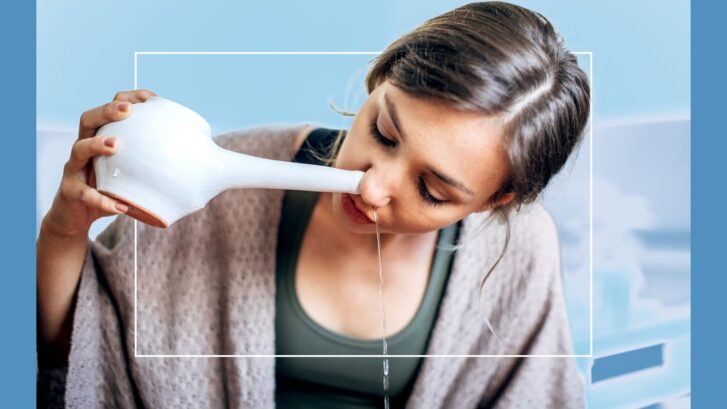Is a Neti Pot Right for You?
Because our concierge primary care doctors in Jupiter have been receiving more questions about the effectiveness of Neti pots for various sinus conditions, we thought we’d take some time to explore their usefulness—and to reiterate a special warning about their use.
What is a neti pot?
Neti pots are one type of nasal irrigation device that use a saline or saltwater solution to treat congested sinuses, colds, allergies, and congestion from flu and COVID-19.
These devices include the teapot-looking container that originated with Ayurvedic medicine in India, along with bulb syringes, squeeze bottles, and more expensive motorized pulsed water devices.
In general, these devices all introduce salt water (saline) into the nostrils to flush out mucus, allergens, and bacteria. The saline helps thin the mucus, making it easier to expel.
The U.S. Food and Drug Administration (FDA) says that such saline rinsing “can remove dust, pollen, and other debris, as well as help to loosen thick mucus. It can also help relieve nasal symptoms of sinus infections, allergies, colds, and flu.
“Plain water can irritate your nose,” the agency says. “The saline allows the water to pass through delicate nasal membranes with little or no burning or irritation.”
How do they work?
“There are various ways to deliver saline to the nose,” says Eric A. Mann, M.D., and Ph.D., a doctor at the FDA.
“Nasal spray bottles deliver a fine mist and might be useful for moisturizing dry nasal passages. But irrigation devices are better at flushing the nose and clearing out mucus, allergens, and bacteria,” he says.
Information that comes with each device can give more specific instructions, but in general, the FDA says they all work basically the same way:
- Leaning over a sink, tilt your head sideways with your forehead and chin roughly level to avoid liquid flowing into your mouth.
- Breathing through your open mouth, insert the spout of the saline-filled container into your upper nostril so that the liquid drains through the lower nostril.
- Clear your nostrils. Then repeat the procedure, tilting your head sideways to the other side.
While some people experience immediate relief from their symptoms, for others it may take a few days to begin breathing more freely.
And experts caution that—like oral decongestants—nasal irrigation devices are simply a treatment for a symptom, not a cure for the underlying cause.
Some Cautions
Although the FDA says that neti pots and other similar nasal irrigation devices are generally safe, they may not be right for everyone. If your immune system isn’t working properly, the agency advises checking with your healthcare provider before using any nasal irrigation system.
A few users report ear discomfort, nasal irritation, a burning or stinging sensation, and even nosebleeds. But in general, the FDA considers them safe to use, even for children aged two and up.
The most significant warning, however, concerns the type of water used in them.
“Tap water isn’t safe for use as a nasal rinse because it’s not adequately filtered or treated,” the FDA cautions.
“Some tap water contains low levels of organisms—such as bacteria and protozoa, including amoebas—that may be safe to swallow because stomach acid kills them. But in your nose, these organisms can stay alive in nasal passages and cause potentially serious infections.”
They can even be deadly, the Centers for Disease Control and Prevention (CDC) reports. Since 1993, there have been at least 70 cases of “brain-eating” amoeba infections in the U.S., which are “almost uniformly fatal,” the agency reports.
Safe Use
The safety of neti pots and other such nasal irrigation devices—including the motorized versions—depends on the type of water used and how meticulously the containers are cleaned after each use.
The FDA lists the following types of water as safe to use for neti pots and similar devices:
- Distilled or sterile water, which you can buy in stores. The label will state “distilled” or “sterile.”
- Boiled and cooled tap water—boiled for three to five minutes, then cooled until it is lukewarm. Previously boiled water can be stored in a clean, closed container for use within 24 hours.
- Water passes through a filter designed to trap potentially infectious organisms. The CDC has information on these filters here.
To safely use and care for your device:
- Wash and dry your hands.
- Check that the device is clean and completely dry.
- Prepare the saline rinse, either with the prepared mixture supplied with the device, or one you make yourself.
- Follow the manufacturer’s directions for use.
- Wash the device, and dry the inside with a paper towel or let it air dry between uses.
Does it Work?
Most people who use neti pots to relieve nasal congestion and allergies swear by them, especially if they want to avoid using over-the-counter decongestants.
“Just about any condition that causes irritants and mucus to build up inside the nose will benefit from saltwater rinsing with a net pot or similar device,” Richard Orlandi, a nasal and sinus specialist and professor of surgery at the University of Utah Health in Salt Lake City, told Consumer Reports (CR).
“These include allergies, nonallergic nose irritation, colds, and sinus inflammation and infections,” he said.
The World Health Organization (WHO) reports that rinsing your nose with saline does not prevent COVID-19, by the way.
If saline rinsing doesn’t relieve your symptoms, or if you have a fever, nosebleeds, or headaches while using the devices, let us know.

